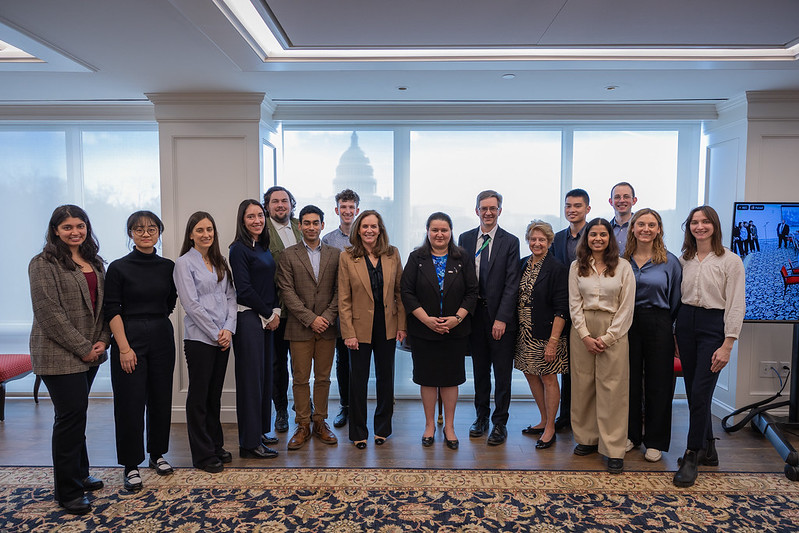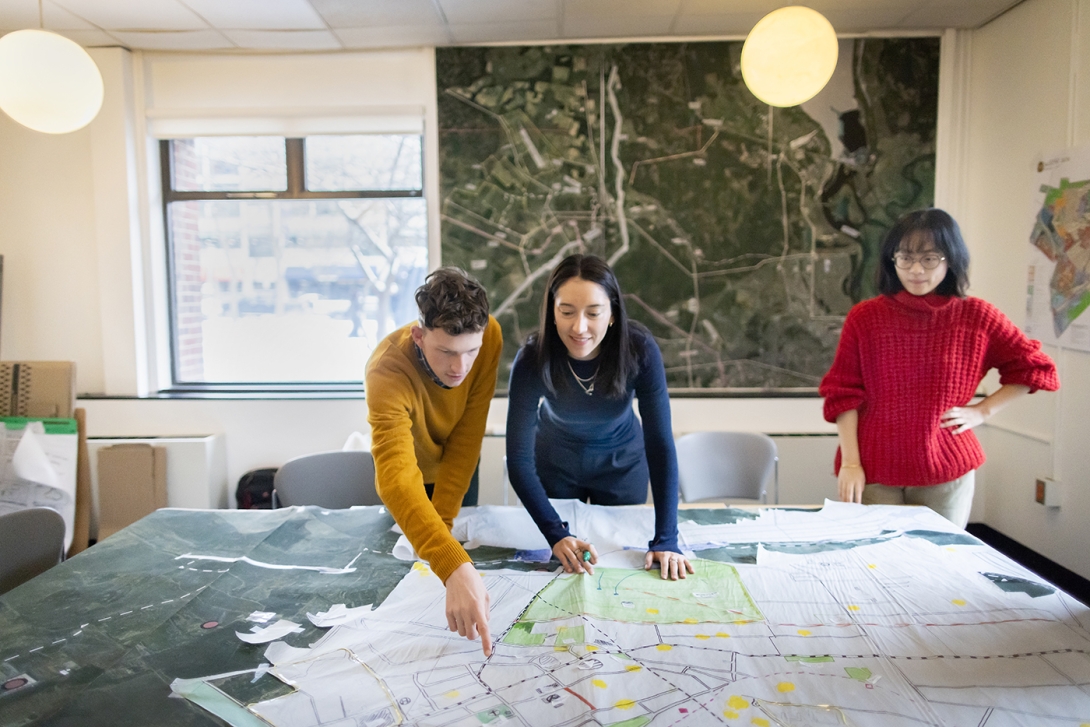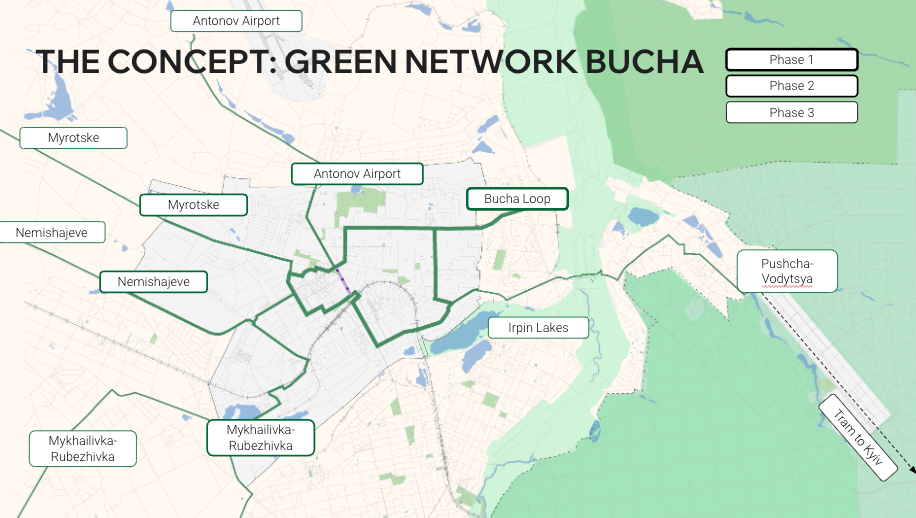In late January 2024, my classmates and I traveled to the Penn Biden Center in Washington, D.C. to present a green infrastructure framework for Bucha, Ukraine, the product of a semester-long class, to an audience including the Ukrainian Ambassador to the United States, Oksana Markarova, and several officials from the U.S. Department of State and U.S. Department of Housing and Urban Development. Unbeknownst to us, the Ambassador is from Bucha, a small city about 30 kilometers northwest of Kyiv that was brutally attacked at the beginning of the 2022 Russian invasion.
The Ambassador kicked off the presentation with somber yet spirited remarks about Bucha’s resilience. She reminded us of the atrocities the world witnessed after the withdrawal of the Russians. Remembering the site of one of the worst horrors, Yablunska Street strewn with civilian bodies, the mass graves, and the destroyed buildings, she told us that while the street is rebuilt as a symbol of Ukrainian strength, the horrible memories, as experienced by the residents, linger. She ended with a reminiscence of the city’s bucolic beauty. This talk was an incredible introduction to the plan we had developed, one grounded in remembrance, the healing qualities of nature, and the hope for a just future that could stimulate economic development.

Weitzman students at the Penn Biden Center in Washington D.C. with Oksana Markarova (Ukrainian Ambassador to the United States), Dorothy McAuliffe (U.S. Special Representative for Global Partnerships, Department of State), John Thompson (Deputy Assistant Secretary for Environment, Department of State) and Dr. Eugenie Birch (Co-Director, PennIUR). Photo: Department of State
We developed the plan, entitled "Green Network Bucha, Rebuild to Reconnect," as part of a Fall 2023 graduate-level city planning course (Topics in International Development: Urban Plans for the Ukraine) at the Weitzman School of Design, taught by Professor of Practice David Gouverneur and Penn IUR Co-Director and Nussdorf Professor Eugenie Birch. The course is the result of a partnership with the U.S. Department of State’s Diplomacy Lab program, a collaboration with U.S. universities that organizes courses around State Department priorities. Our work began with considering how to make meaningful recommendations for a place shocked by recent atrocities yet steadfastly determined to reconstruct. Typically, place-based courses incorporate fieldwork, but this was impossible with this class.
So without direct access to Bucha and its residents, we sought information from a variety of authorities and places. Department of Historic Preservation professors Randall Mason and Lynn Meskill, who have deep experience with remembrance/ heritage destruction from their work in Rwanda, Syria, and Iraq provided particularly relevant advice that informed our thinking about memorials. Ukrainian Andrew Melnyk, representing the Bucha City Council, provided access to such basic but embargoed sources as Bucha’s pre-war comprehensive plan that helped us identify areas of growth (largely disconnected from the core city) as well as key open spaces scattered in and around the city. Perhaps most important, in our search for real-time data, we quickly pivoted to social media to learn from first-hand accounts. For example, user-generated content on a fitness app revealed locals’ desire lines – a series of popular off-road and often disconnected running, walking, biking, and kayaking trails. We then cross-referenced Google Street View with military maps of severe bombing and Flickr to identify local road typologies and how they may be changing through reconstruction.
To develop a sense of Bucha’s structure and organization, we worked in two scales, first on two gigantic maps, so large that they covered areas 6’ by 6’ laid out in the Penn IUR conference room and later on GIS maps that we integrated into our PowerPoint presentation. We used the large map to experience the city – with pens and other markers, informed by social media, we “walked” the streets, “seeing” the parks, rivers, roads and highways, logistics and economic nodes (airport, railroad), social and cultural landmarks ( stadium, Church of St. Andrew the First [site of the mass graves], Yablunska Street), and new developments (proposed TechnoGarden, residential clusters). While we overlaid the damage reports, we did not have a real time idea of the ongoing reconstruction. However, from time to time, we consulted with Mr. Melnyk who urged us on, saying that the city really did need help in rebuilding.

Weitzman students Leo Wagner, Laura Frances, and Chenxi Zhu prepare for their January 26th presentation. Photo: Eric Sucar
As we began to get a stronger sense of conditions on the ground, we translated Bucha’s comprehensive plan and mapped out growth zones in and around Bucha. Our layered approach revealed a unique opportunity to link Bucha’s surrounding greenbelt to its urban assets with a climate-resilient infrastructure plan that could strengthen its street grid and enhance access to its natural assets all while inviting locals and visitors to connect with the city’s sites of remembrance. Once we had developed the concept, we turned to thinking about its refinement and later implementation. We viewed the framework as a vehicle for discussion with the residents to refine the locations. We suggested a phasing plan to build it out. We offered illustrations as design examples for streetscapes along the highway, for jogging/biking/walking trails and around key mobility points. We identified potential sources of funding and supportive partnerships.

Students proposed a three-phased implementation framework for the pedestrian bike network in and around Bucha, Ukraine.
After we finished presenting, the Ambassador noted that our network plan connected to places that one would not find in any guidebook about Bucha but are meaningful to locals - a comment that validated our nontraditional methodology. She also remarked how if the network was built, her kids could safely bike to school.
Finally, we concluded the discussion with a small ceremony in which we presented hard copies of the work along with a translation in Ukrainian contributed by Alex Jarymovych, IT Director, Weitzman School to the ambassador and to the State Department representatives.
As the intent of Green Network Bucha is to be a visionary framework on top of which locals like the Ambassador can dream up scenarios of how the pedestrian/bike network could enhance their daily lives, we were surprised that coverage by the Voice of America, as well as social media produced by members of the audience including the Ambassador, have led to contacts with Bucha leaders who want to continue the dialogue about the plan, an ongoing opportunity to share ideas and support with these new colleagues.

